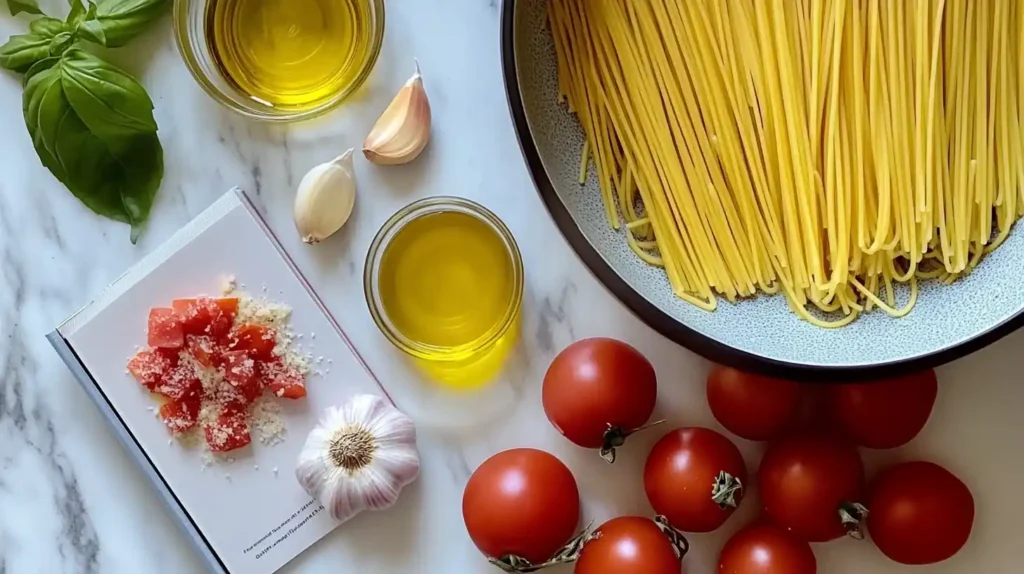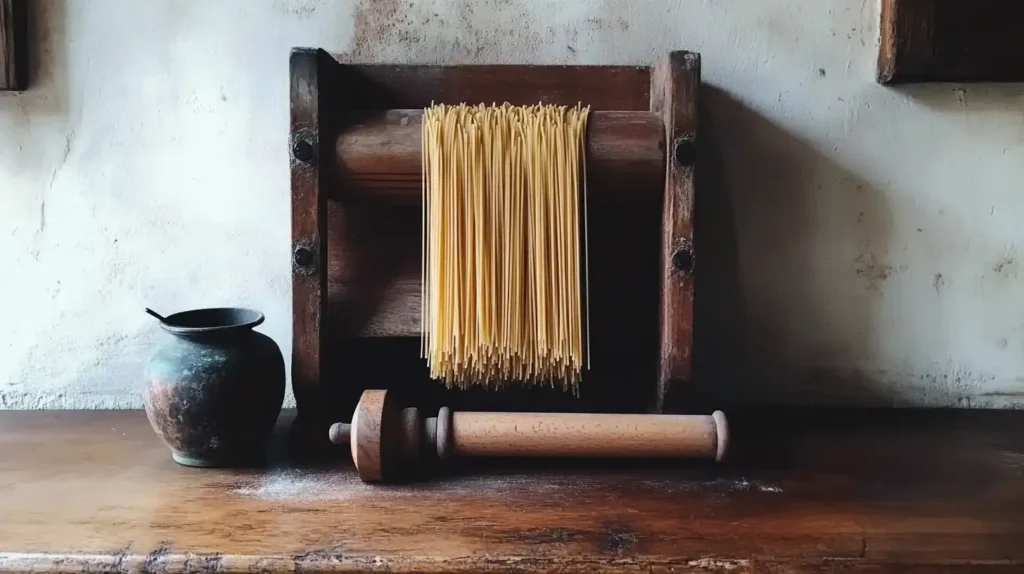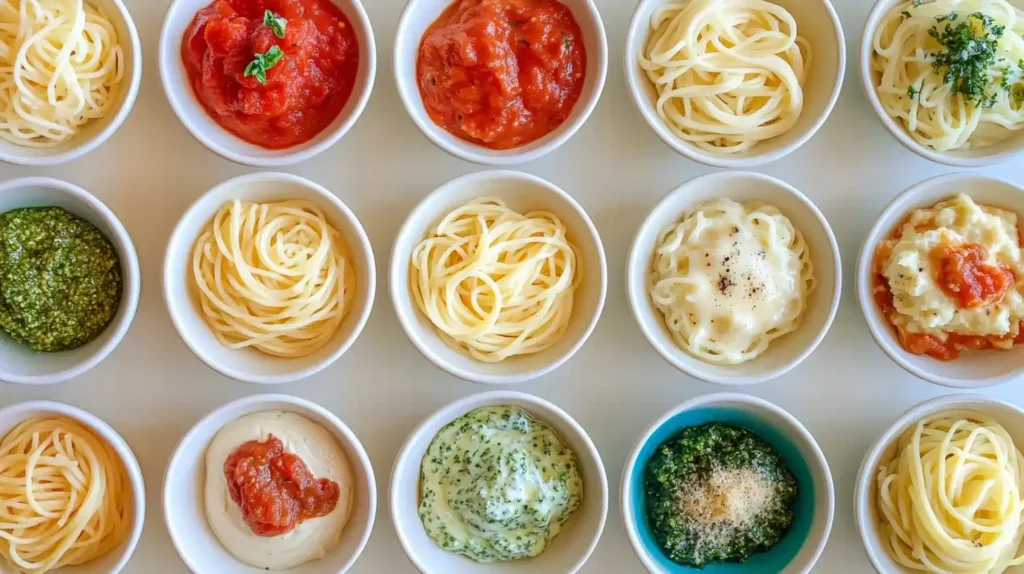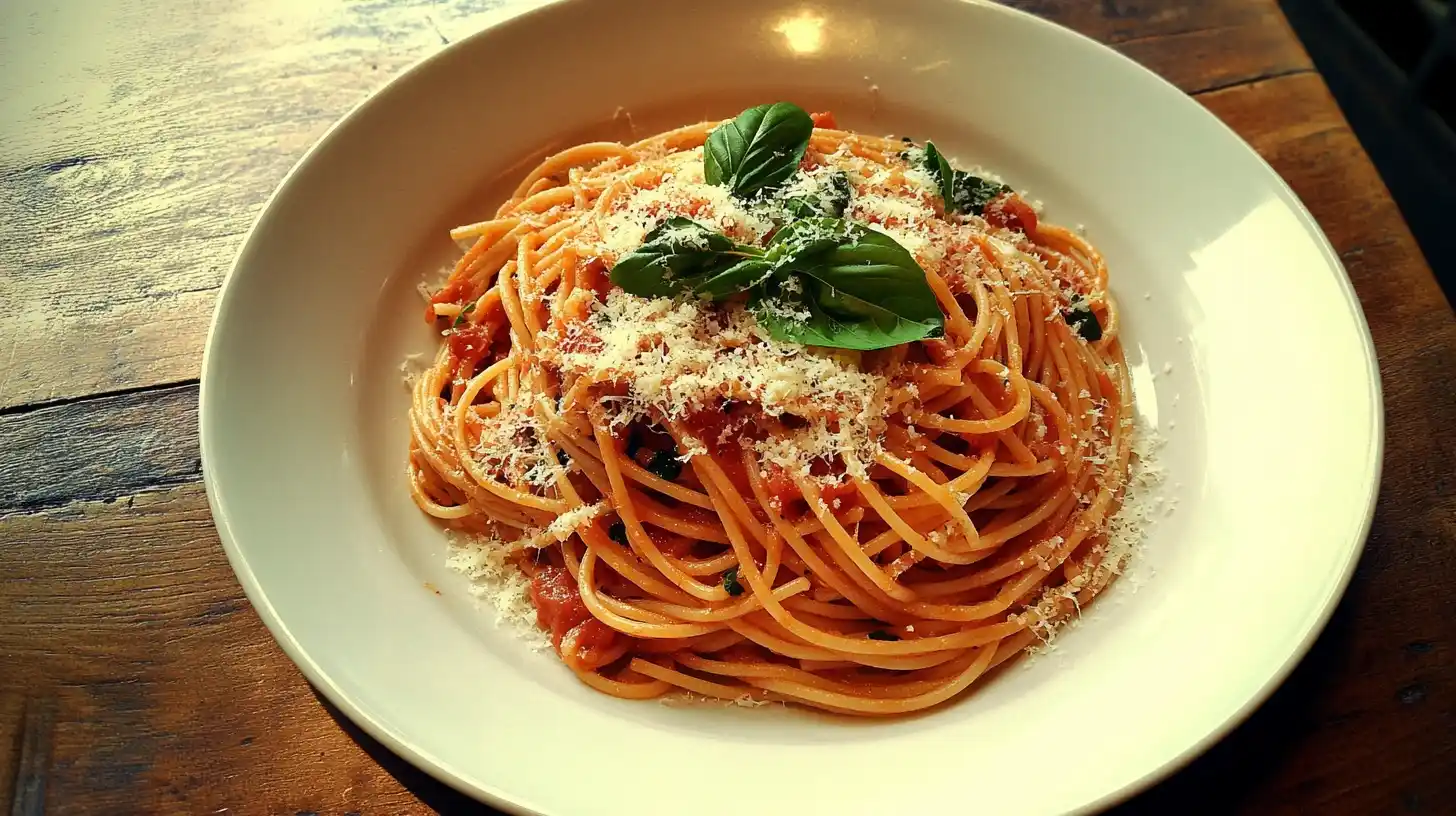Spaghetti is one of the most well-known pasta varieties worldwide. Its long, thin strands and adaptability make it a favorite in households and restaurants alike. Originating in Italian cuisine, it has since become a global icon of comfort food. Whether served with a simple tomato sauce or a rich seafood blend, spaghetti never fails to impress.
For a more in-depth look at different pasta types, explore The Ultimate Guide to Fettuccine, which highlights another popular pasta shape
While spaghetti originated in Italian cuisine, it has now become a worldwide favorite.
Whether you enjoy it with a simple tomato sauce, creamy alfredo, or seafood, it always delivers a satisfying meal. Furthermore, its versatility means you can create endless dishes using this one ingredient.
In addition, spaghetti is often praised for how it can be adapted to suit different dietary needs. For example, there are gluten-free and whole-grain options available, making it accessible to more people. As a result, it has earned its place as a go-to choice for quick and delicious meals.
Table of contents

The History of What is Spaghetti in Pasta
The story of spaghetti begins centuries ago in Italy. Its name comes from the Italian word “spago,” which means “string” or “twine.” This name perfectly describes the shape of this long, thin pasta. Early mentions of pasta in Italy date back to the 12th century. During this time, pasta-making techniques spread across the Mediterranean, influencing Italian cooking.

Britannica suggests that spaghetti likely gained popularity due to its ease of preparation and storage. At first, people made it with basic ingredients such as wheat flour and water. Olive oil, cheese, and herbs were often used as toppings. These simple meals were affordable and easy to make, which helped them gain popularity.
As trade routes expanded, new ingredients like tomatoes became widely available. This evolution turned spaghetti into a dish paired with rich, flavorful sauces. Over time, it grew to symbolize Italian culture and cuisine. Today, it is enjoyed worldwide, often featured in dishes such as spaghetti bolognese and carbonara.
Moreover, spaghetti is not just food it is a tradition. Many families gather to share meals featuring this beloved pasta, keeping its cultural significance alive. Its history shows how food can bring people together and adapt over time to meet changing tastes and needs.
How is Spaghetti Made?
Classic spaghetti is crafted from simple ingredients: wheat flour and water. Some versions include eggs for a richer texture. Today, machines shape the dough into its signature long strands and dry them for easy storage. This process ensures consistent quality and flavor.
If you’re interested in comparing different pasta varieties, read about The Difference Between Spaghetti and Spaghettini, which highlights their unique characteristics.
Today, most spaghetti is made using modern machines. The process begins by mixing the ingredients into a smooth dough. This dough is then pressed through special molds to create the familiar long, thin shape. Afterward, the strands are carefully dried to ensure they last longer and remain easy to cook.
The drying process is crucial. It allows the spaghetti to be stored for months without losing its quality. The result is a pasta that cooks evenly and pairs beautifully with different sauces.
In addition, there are now many varieties of spaghetti to suit different diets. Whole-grain versions provide more fiber, while gluten-free options cater to those with dietary restrictions. These choices make spaghetti accessible to nearly everyone.
Because of its simple ingredients and efficient production methods, spaghetti has become a favorite around the world. It is both affordable and convenient, making it a reliable choice for busy families and professional chefs alike.
What Makes Spaghetti Unique in Pasta?
Spaghetti stands out from other types of pasta for several reasons. Its long, thin shape makes it ideal for holding and soaking up sauces. This shape also gives it a pleasing texture when cooked al dente firm yet tender. Because of this, it is a favorite choice for many dishes, from simple meals to gourmet creations.
One of the key features of spaghetti is its versatility. It pairs well with almost any type of sauce, whether it’s tomato-based, creamy, or even seafood-infused. For example, classic dishes like spaghetti bolognese and spaghetti carbonara highlight how this pasta can adapt to rich and flavorful recipes. On the other hand, lighter sauces, such as olive oil with garlic, bring out the pasta’s natural taste.
Another unique quality of spaghetti is how it appeals to people with different dietary preferences. With options like whole-grain and gluten-free spaghetti, everyone can enjoy this classic pasta. As a result, it has become a staple food in households worldwide.
Furthermore, its ability to adapt to different cuisines makes it a global favorite. From spicy spaghetti arrabbiata in Italy to Asian-inspired noodle dishes, its flexibility knows no bounds. Because of its universal appeal, spaghetti continues to be one of the most loved types of pasta.
Common Uses of Spaghetti
Spaghetti is among the most flexible and widely used pasta varieties. Its ability to pair with a wide variety of ingredients and sauces makes it a favorite for many recipes. Whether you are preparing a quick weekday meal or a special dinner, spaghetti is always a reliable choice.
Classic Italian Dishes with What is Spaghetti in Pasta
In Italian cuisine, spaghetti is a key ingredient in many beloved recipes:
- Spaghetti Bolognese: A hearty dish made with a rich meat sauce.
- Spaghetti Carbonara: A creamy, savory pasta featuring eggs, cheese, and pancetta.
- Spaghetti Pomodoro: A simple yet delicious dish made with fresh tomatoes, olive oil, and basil.
These dishes highlight the adaptability of spaghetti in both traditional and modern Italian cooking.
Global Variations
While spaghetti is rooted in Italy, it has been embraced by cuisines worldwide. In Asia, for example, it is often incorporated into fusion dishes, such as stir-fries with soy sauce and vegetables. Similarly, in the United States, baked spaghetti casseroles are a popular comfort food.
Its flexibility allows chefs and home cooks alike to experiment with flavors from around the world, making it a global culinary icon.
Healthier Alternatives to What is Spaghetti in Pasta
Today, many people look for healthier options when choosing pasta. Whole-grain spaghetti offers more fiber and nutrients, while gluten-free varieties cater to those with dietary restrictions. These alternatives ensure that everyone can enjoy spaghetti, regardless of their health needs or preferences.

Because of its simplicity and ability to blend with diverse flavors, spaghetti remains a pantry staple. It allows for endless creativity in the kitchen, proving that this humble pasta is anything but ordinary.
FAQs About Spaghetti
Here are some common questions people ask about spaghetti. These answers highlight why it is so popular and how it can be enjoyed in different ways.
1. What is the difference between spaghetti and pasta?
All spaghetti is a type of pasta, but not all pasta qualifies as spaghetti. Pasta is a broad term that includes many shapes and sizes, while spaghetti refers specifically to its long, thin, cylindrical form.
2. Why is spaghetti so popular?
Spaghetti is popular because it is easy to cook, affordable, and incredibly versatile. It pairs well with a wide range of sauces and ingredients, making it suitable for any meal, from quick lunches to elegant dinners.
3. How do Italians traditionally serve spaghetti?
In Italy, spaghetti is often served with simple sauces like pomodoro (fresh tomato) or aglio e olio (olive oil and garlic). Italians focus on letting the flavor of the pasta itself shine through, often topping it with freshly grated Parmesan or Pecorino cheese.
4. Can spaghetti be made without wheat?
Yes! Gluten-free spaghetti is widely available. It is made from ingredients like rice, corn, or quinoa, making it suitable for those with gluten sensitivities or allergies.
5. Is spaghetti healthy?
Spaghetti can be part of a healthy diet, especially when paired with nutrient-rich sauces and vegetables. Whole-grain versions offer added fiber and nutrients, while portion control helps keep meals balanced.
6. What are some creative ways to use spaghetti?
Aside from traditional dishes, you can use spaghetti in casseroles, soups, or even stir-fries. It is also great as a base for cold pasta salads when mixed with fresh veggies and light dressings.
These frequently asked questions show how spaghetti continues to be a favorite choice for its convenience, adaptability, and universal appeal.
Cooking and Serving What is Spaghetti in Pasta
Cooking spaghetti perfectly is simple, but a few tips can make a big difference in the final result. When prepared properly, spaghetti has a firm texture and absorbs sauces beautifully. Here’s how to cook and serve it for the best flavor and experience.
Step-by-Step Cooking Guide
- Boil the Water: Use a large pot with plenty of water. Add a generous pinch of salt to bring out the pasta’s flavor.
- Add the Spaghetti: Once the water is boiling, drop in the spaghetti. Stir occasionally to prevent it from sticking together.
- Cook Until Al Dente: Follow the package instructions, usually 8–10 minutes. For a perfect al dente texture, test a strand by biting into it; it should be firm but not hard.
- Drain, but Save Some Water: Before draining, save a cup of the cooking water. This starchy water can help blend your sauce and pasta seamlessly.
Tips for Serving What is Spaghetti in Pasta
- Pair it with the Right Sauce: Light sauces like olive oil or garlic are perfect for simple meals, while richer sauces like marinara or carbonara work well for more indulgent dishes.
- Add Fresh Toppings: Enhance the dish with grated Parmesan, fresh herbs like basil, or a drizzle of extra virgin olive oil.
- Mix Before Serving: Toss the cooked spaghetti with the sauce in the pan for even coating and better flavor absorption.
Common Mistakes to Avoid
- Don’t rinse the pasta after draining; it washes away the starch that helps the sauce stick.
- Avoid adding oil to the boiling water it can prevent the sauce from clinging to the spaghetti.
Creative Serving Ideas for What is Spaghetti in Pasta
- Baked Spaghetti: Combine spaghetti, marinara sauce, and cheese, then bake until bubbly for a comforting dish.
- Spaghetti Salad: Toss cooked spaghetti with fresh veggies, a light vinaigrette, and some herbs for a refreshing cold salad.
- Spaghetti Stir-Fry: Use leftover spaghetti in a quick stir-fry with soy sauce, garlic, and your favorite vegetables.
With these tips and ideas, you can make the most of spaghetti in your kitchen, creating meals that are both simple and delicious.
Perfect Pairings for Spaghetti in Pasta
The beauty of spaghetti lies in its ability to complement a variety of flavors. The right sauce or topping can transform a simple meal into something extraordinary. Here are some of the best pairings to elevate your spaghetti dishes.
Tomato-Based Sauces
Tomato-based sauces are classic partners for spaghetti. Their acidity balances the pasta’s mild flavor, creating a satisfying dish.
- Marinara Sauce: A simple blend of tomatoes, garlic, and olive oil makes this a go-to choice.
- Arrabbiata Sauce: If you like a bit of spice, this sauce adds a fiery kick with chili peppers.
- Pomodoro Sauce: Fresh tomatoes and basil come together for a light, refreshing taste.
Creamy Sauces for What is Spaghetti in Pasta
Creamy sauces add richness and depth to spaghetti. They are perfect for indulgent meals.
- Alfredo Sauce: A blend of butter, cream, and Parmesan creates a velvety smooth sauce.
- Carbonara: Eggs, cheese, and pancetta combine for a savory, creamy finish.
- Cheesy Tomato: A mix of cream and tomato sauce brings the best of both worlds.
Seafood Pairings
Seafood enhances the delicate texture of spaghetti. The combination is especially popular in Mediterranean cuisine.
- Spaghetti with Clams: A light, flavorful dish with olive oil, garlic, and fresh clams.
- Shrimp and Lemon: Tossed with lemon juice and garlic, this pairing is both tangy and refreshing.
- Tuna Puttanesca: Olives, capers, and tuna create a bold, salty dish.
Vegetarian Options for What is Spaghetti in Pasta
For lighter meals, pair spaghetti with fresh vegetables and herbs.
- Pesto Sauce: Made from basil, pine nuts, and olive oil, pesto brings vibrant flavors to your dish.
- Vegetable Medley: Combine sautéed zucchini, bell peppers, and mushrooms for a colorful, healthy meal.
- Garlic and Olive Oil: A minimalist pairing that allows the natural flavor of spaghetti to shine.
Tips for Enhancing Pairings
- Add grated Parmesan or Pecorino Romano for extra flavor.
- Use fresh herbs like basil, parsley, or oregano to brighten your dish.
- To add some heat, sprinkle red pepper flakes on top.
By choosing the right pairing, you can create spaghetti dishes that suit any occasion, from casual dinners to special celebrations.
Conclusion
Spaghetti is more than just a type of pasta it’s a global favorite that brings people together through its simplicity and versatility. Its long, thin strands make it perfect for holding sauces, while its ability to pair with almost any ingredient ensures endless possibilities in the kitchen.
Over the centuries, spaghetti has evolved from a humble Italian dish to a worldwide culinary icon. Its rich history reflects how food can adapt and thrive across cultures. Today, whether you enjoy it in a traditional Italian recipe like spaghetti carbonara, a hearty bolognese, or an innovative fusion dish, spaghetti continues to delight and inspire.
Because of its ease of preparation and variety of options, spaghetti is a reliable choice for both busy weeknights and elegant dinners. You can explore healthier versions like whole-grain or gluten-free options, experiment with sauces, or create your own unique recipes.
In the end, spaghetti is not just about the food it’s about the experience. The joy of sharing a meal, experimenting with flavors, and savoring every bite makes spaghetti a timeless favorite. So, why not try a new recipe today and rediscover the magic of this beloved pasta?

